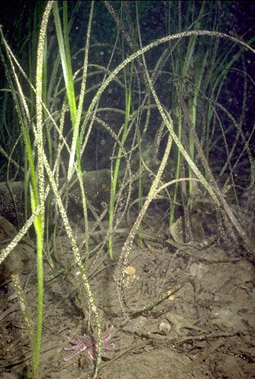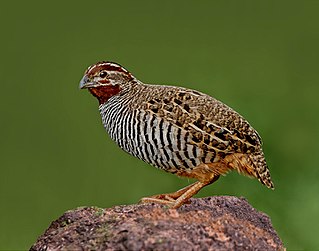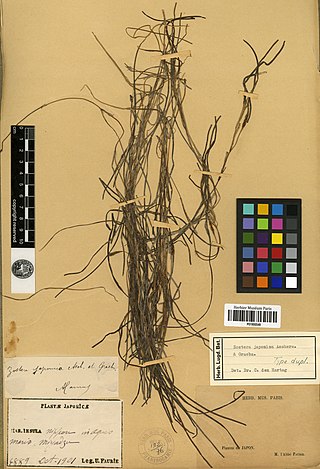
Zostera is a small genus of widely distributed seagrasses, commonly called marine eelgrass, or simply seagrass or eelgrass, and also known as seaweed by some fishermen and recreational boaters including yachtsmen. The genus Zostera contains 15 species.

The brant or brent goose is a small goose of the genus Branta. There are three subspecies, all of which winter along temperate-zone sea-coasts and breed on the high-Arctic tundra.

The jungle bush quail is a species of quail in the family Phasianidae. It is native to the Indian subcontinent, where it is found in peninsular India and Sri Lanka. It has also been reported from Nepal but has not been seen there since the 19th century, and an introduced population exists on the island of Réunion. A small species of quail 15–18 cm (5.9–7.1 in) long and weighing 57–82 g (2.0–2.9 oz), it shows significant sexual dimorphism. Males have brown upperparts with blackish and buff marking and whitish underparts with black barring. The face is mainly dark reddish-brown, with brown ear-coverts, a buffy-white moustachial stripe, and the supercilium turning whitish towards the back of the neck. Females have a similar pattern, but with pinkish-brown underparts, more uniform wings, and duller moustachial stripes.

Centella asiatica, commonly known as Indian pennywort and Asiatic pennywort, is a herbaceous, perennial plant in the flowering plant family Apiaceae. It is native to tropical regions of Africa, Asia, Australia, and islands in the western Pacific Ocean. It is consumed as a culinary vegetable and is used in traditional medicine.

The Cape golden mole is a small, insectivorous mammal of the family Chrysochloridae, the golden moles. The species is a solitary subterranean insectivore, confined to the coastal regions of the southwestern and southern Cape in South Africa. When foraging for small, soil invertebrates and small lizards, these golden moles excavate superficial burrows using their conical nose shield and highly modified forefeet. Females are smaller than males. Golden moles have very dense, soft, and silky coats. The coats are colored blackish to slaty-grey and brown to pale fawn. They have also been observed to venture onto sandy beaches, presumably to feed on amphipods and isopods occurring there.

The white-winged dove is a dove whose native range extends from the Southwestern United States through Mexico, Central America, and the Caribbean. They are large for doves, and can be distinguished from similar doves by the distinctive white edge on their wings. They have a blue eyering, and red eyes. The plumage is brownish-gray to gray. Juveniles are duller in color, and have brown eyes. The call is likened to English phrase "who cooks for you". There are three subspecies. It was first described by George Edwards in 1743, and given its binomial name by Linnaeus in 1756. It was moved into the genus Zenaida in 1838.
Lottia alveus, the eelgrass limpet or bowl limpet, was a species of sea snail or small limpet, a marine gastropod mollusk in the family Lottiidae, the Lottia limpets, a genus of true limpets. This species lived in the western Atlantic Ocean.

Barringtonia asiatica is a species of Barringtonia native to mangrove habitats from islands of the Indian Ocean in the west to tropical Asia and islands of the western Pacific Ocean. It is grown along streets for decorative and shade purposes in some parts of India, for instance in some towns on the southeastern shore. It is also known as Box Fruit due to the distinct box-shaped fruit it produces. The local name futu is the source of the name for the Polynesian island Futuna. The type specimen was collected by botanist Pehr Osbeck on a sandy beach area on the island of Java, later to be described by Carl Linnaeus in his Species Plantarum in 1753.

Zostera marina is a flowering vascular plant species as one of many kinds of seagrass, with this species known primarily by the English name of eelgrass with seawrack much less used, and refers to the plant after breaking loose from the submerged wetland soil, and drifting free with ocean current and waves to a coast seashore. It is a saline soft-sediment submerged plant native to marine environments on the coastlines of northern latitudes from subtropical to subpolar regions of North America and Eurasia.

Lathrecista asiatica, the asiatic blood tail, is a species of dragonfly in the family Libellulidae. It is the only species in its genus. It is widespread, occurring from India to Australia.

Zostera noltii is a species of seagrass known by the common name dwarf eelgrass. It is found in shallow coastal waters in north western Europe, the Mediterranean Sea, Black Sea, Caspian Sea and Aral Sea and on islands in the Atlantic off the coast of northwest Africa. It is an important part of the intertidal and shallow subtidal ecosystems of estuaries, bays and lagoons.
Zostera novazelandica Setchell is a species of seagrass in the family Zosteraceae found on the shores of New Zealand. It is regarded as a distinct species by some authors but considered as a synonym of Zostera muelleri Irmisch ex Ascherson by others. The Maori names for Zostera novazelandica are karepō, nana, rehia, and rimurehia.

Zostera japonica is a species of aquatic plant in the Zosteraceae family. It is referred to by the common names dwarf eelgrass or Japanese eelgrass, and is native to the seacoast of eastern Asia from Russia to Vietnam, and introduced to the western coast of North America. It is found in the intertidal zone and the shallow subtidal, and grows on sandy, muddy and silty substrates.
Zostera caespitosa is a species of eelgrass native to the shores of northeastern Asia: Japan, Korea, northeastern China (Liaoning), and the Russian Far East.
Zostera muelleri is a southern hemisphere temperate species of seagrass native to the seacoasts of South Australia, Victoria and Tasmania. and New Zealand. Today, Zostera muelleri can be found in regions of Australia, New Zealand, and Papua New Guinea, as well as areas of the eastern Indian Ocean, and the southwest and western central Pacific Ocean. Zostera muelleri is a marine angiosperm, and is commonly referred to as eelgrass or garweed. It is a fast growing and readily colonizing species that serves as a feeding ground for wading birds and aquatic animals, and a breeding ground for juvenile fish and shrimp species.
Zostera tasmanica is a species of marine eelgrass in the Zosteraceae family. It is native to the seacoasts of Tasmania, New South Wales, Victoria, South Australia, and Western Australia.
Zostera caulescens is a species of eelgrass native to the shores of northeastern Asia: Japan, Korea, northeastern China (Liaoning), and the Russian Far East.
Zostera polychlamys is a species of eelgrass native to the shores of South Australia and Western Australia. It was first discovered at Flinders Bay in Western Australia in 1990.
Zostera nigricaulis is a species of eelgrass native to the seacoasts of New South Wales, Victoria, South Australia, Western Australia and Tasmania, and across the Pacific in Chile. It was first discovered on Kangaroo Island in South Australia in 1988.

The Siberian house martin or eastern house martin is a passerine bird in the swallow family Hirundinidae. It breeds in rocky areas of northeastern Russia, Mongolia and northern China and winters in Myanmar, Laos, Vietnam and Cambodia. It was formerly considered conspecific with the common house martin.












